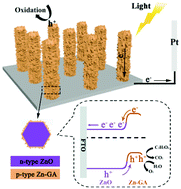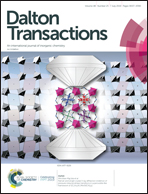Improving photoelectrochemical response of ZnO nanowire arrays by coating with p-type ZnO-resembling metal–organic framework†
Abstract
Coupling semiconducting metal–organic frameworks (MOFs) with metal oxide (MO) semiconductor nanowires is an efficient solution to tune the photoelectric properties of both the parties. In this report, we demonstrate a facile surfactant-free growth strategy for modification of zinc oxide (ZnO) single-crystal nanowire arrays (NWAs) with the MOF zinc glycolate (noted as Zn-GA) that contains an embedded continuous 3D Zn–O network. Due to the structural resemblance of the Zn–O network between Zn-GA and ZnO, the prepared ZnO@Zn-GA nanowires present a tight contact at the core–shell interface in a partially epitaxial manner, and the loading amount of Zn-GA can be well controlled in the synthetic process. The inherent p-type Zn-GA in combination with the widely available n-type ZnO assures the construction of tandem n–p heterojunctions at the core–shell interface, which is confirmed by Mott–Schottky analysis. By implementation of the ZnO@Zn-GA NWAs as photoanodes for photoelectrochemical oxidation of water and oxalic acid, improved photocurrent responses are obtained relative to the primary ZnO NWAs. The most significant photoresponse is observed in the ZnO nanowires shelled by a compact Zn-GA particulate thin film with the largest junction region. These results are elucidated by the enhanced spatial separation efficiency of photogenerated charge carriers, which is favored by the built-in electric field at the interface of the n–p heterojunctions.

- This article is part of the themed collection: Spotlight Collection: Atomic and Molecular Layer Deposition


 Please wait while we load your content...
Please wait while we load your content...